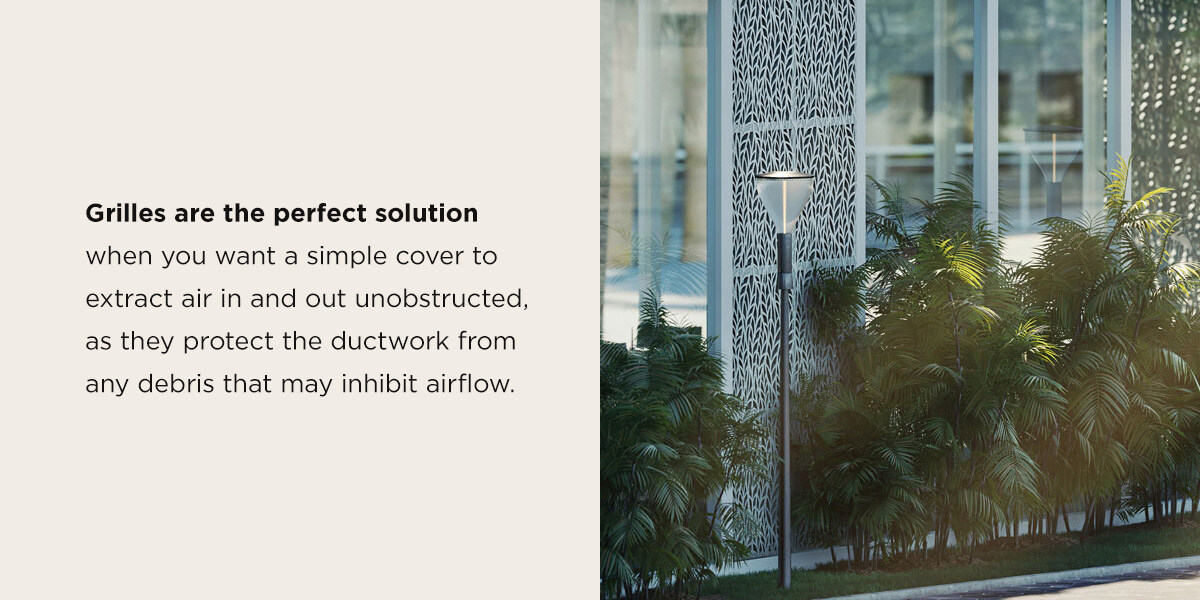Heating, ventilation and air conditioning (HVAC) systems supply and distribute air throughout buildings to maintain healthy indoor air quality. These systems use vent covers to control the direction and amount of airflow. There are three standard options for vent covers — grilles, registers and diffusers.
With the right planning and product selection, ventilation can save indoor users from air pollutant-related illnesses, allergic reactions and discomfort. Learn more about ventilation and the difference between HVAC grilles, diffusers and registers in this guide.
The Importance of Ventilation
While most people know that ventilation in buildings is essential, many are unaware of the impact of poor ventilation on comfort and health. Building owners typically invest in heating or cooling equipment and want an indoor space that's efficiently sealed to avoid air leakage and preserve energy. However, a completely sealed building also means that pollutants and humidity have nowhere to escape.
Most indoor spaces contain contaminants like dust, lead, mold, radon, pests, carbon monoxide, pet dander and second-hand smoke. Without sufficient ventilation, these pollutants build up and cause unpleasant odors, trigger allergic reactions and cause respiratory issues. Moreover, limited air circulation traps humidity and creates the perfect environment for mold and bacteria. With a well-planned ventilation system, you can clear out stale, polluted air and keep building occupants happy and healthy.
There are two common types of building ventilation methods:
- Natural ventilation: This method uses natural air circulation through windows, solar chimneys, small gaps and trickle vents around the building.
- Mechanical ventilation: This method uses mechanical systems and devices to replace the air through fans, ducts, vents and air filters.
Ventilation Cover Options
Ventilation requires a certain degree of control to work effectively. Vent covers aid in ventilation control by adjusting the air intake and exhaust rate, flow direction, and balance throughout the building. A vent cover also serves as an aesthetic seal over gaping holes and outlets in HVAC systems, allowing them to appear more seamless.
The three main cover types are grilles, registers and diffusers.
Grilles
A vent grille is the least complex ventilation cover, as its primary function is to allow air to pass through it. They consist of a cover with a fixed pattern of openings suitable for air intake and exhaust outlets. Since grilles don't have any moving components or dampers, they're also one of the easiest to maintain.
Grilles are the perfect solution when you want a simple cover to extract air in and out unobstructed, as they protect the ductwork from any debris that may inhibit airflow. Most people use ventilation grilles for walls to allow air to flow from one area or room to another, but they also work over duct openings and air vents.
However, what the grille has in simplicity, it lacks in function. Due to most grilles being static covers, a grille will not be suitable if you want to be able to adjust airflow direction or the amount flowing in and out.

Registers
Registers and grilles are similar, but registers have adjustable dampers. They're only suitable for air supply outlets where air from the HVAC system blows out of the air ducts into the space. The dampers help to control the airflow direction or shut off the flow, similar to the adjustable vents of a car's aircon outlet.
Most aircon ducts and mechanical ventilation outlets use registers to control where the air is going, and you'll find them on walls, ceilings and even floors. Some buildings like hotels and malls may opt for grilles with slots set at an angle. These allow for a fixed airflow direction but do not offer the control flexibility of regular registers.
Diffusers
While similar to registers, a diffuser differs in terms of the airflow direction variability. An air grille diffuser's structure and dampers are designed to face multiple directions, unlike a register that only allows for a single airflow direction. Many diffusers are found on ceilings, often covering an aircon or air release outlet. Diffusers vary the most, amongst the three, in design.
Most diffusers come in square or circular shapes with vents designed to match the diffuser's shape. There are some unique diffuser designs, such as eyeball diffusers. These diffusers consist of a sphere within a holder that can be rolled to point the sphere air opening in any direction. A diffuser is effective when you need to distribute air evenly around a room or in specific paths at once. However, the airflow path depends on the damper's design and position.
How to Choose Between Grilles, Registers and Diffusers
Each vent covering serves a particular function, so it's helpful to consider your requirements when making a decision.
- Grilles are suitable for simple applications where you need air to flow in and out of an opening or HVAC system.
- Registers are best when you need more control over the airflow coming out of an HVAC system.
- Diffusers are for a multi-directional air release.
Choose Jonite for Modern Ventilation Grilles
Most ventilation grilles focus primarily on function, ensuring air passes through easily. While they work well, these vents are typically non-decorative. At Jonite, we've created an aesthetically pleasing vent grille option for designers looking to add a beautiful and modern yet functional statement piece to their buildings.
Our grilles are made from our one-of-a-kind reinforced stone, which mimics the rustic appeal of natural stone but with added durability and load-bearing performance. Our main grille design is inspired by forests and natural tropical patterns, increasing the grilles' visual appeal and helping them blend in with greenery in outdoor spaces. We offer complete product customization, so you can alter the color, texture, size and pattern to suit your project and application.
Find out more about our reinforced stone ventilation grilles and contact us today for a quote! We look forward to helping you meet your design goals.











